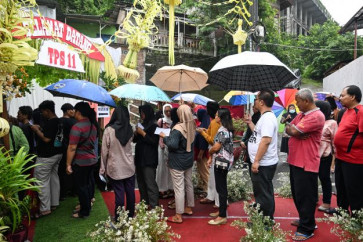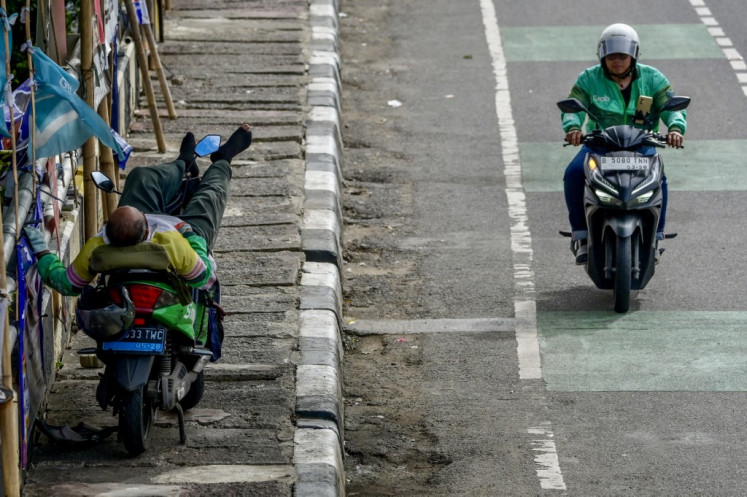Surabaya’s heritage buildings in peril
Poor ants: A pedicab passes Surabaya Kota railway station, also called as Semut station, which is now used as a parking lot
Change Size

P
span class="inline inline-left">Poor ants: A pedicab passes Surabaya Kota railway station, also called as Semut station, which is now used as a parking lot.On May 31, Surabaya is 719 years old.
Although no longer young, and in spite of its reputation as the city of heroes, the East Java provincial capital still seems unable to show proper appreciation of the historic buildings handed down as part of its cultural heritage by its founding fathers and mothers.
Many of the old structures closely connected with the history of Surabaya are poorly managed. Sooner or later, the historic monuments now left in such disrepair will not be able to withstand the ravages of time.
The consequences are predictable. With the buildings doomed to ruin, various interested parties will have an apparently valid argument to justify the demolition of the venerable structures and their replacement by modern architectural constructions.
As witnesses to the history of the city, the old buildings should be preserved with greater attention and appreciation. In reality, this is not the case. The few buildings now left are located in northern Surabaya, a port area and business center boasting many historic relics, including the Han family’s Crematory, over 300 years old.
“The true spirit of Surabaya actually lies in the city’s traditional kampongs and historic buildings, which is the reason why these districts of Surabaya have been rated the best among Indonesia’s seven major cities,” Freddy H. Istanto, director the Surabaya Heritage Society (SHS), told The Jakarta Post recently.
According to Freddy, when he is asked to accompany foreign tourists from Europe, particularly Holland, for a sightseeing trip in Surabaya, one of their agendas is always a visit to the city’s older neighborhoods by cruising from one heritage structure to another.
Such buildings as Semut railway station, the drawbridge in Kalimas, the former Kalisosok prison and the Youth Center complex, which was razed by fire not long ago, are definitely on their list.
Ironically, the old constructions that can serve as a magnet for tourists visiting Surabaya are now overwhelmed by the pace of development in the name of modernization. The decreasing number of heritage structures in the city has been noticeable since the 1970s.
Many old buildings, some of which were controlled by private individuals, have now become shop-houses, hotels and supermarkets. The demands of business, inconsistent implementation of regulations and ineffective inter-agency coordination have caused this failure to protect and preserve historic places.
Surabaya Kota railway tation, better known as Semut, for instance, one of the 10 oldest railway stations in Indonesia and built in 1870, was demolished by the state railway company PT Kereta Api (PT KA) in 2003 for reasons of zone expansion. Even though in September 1996 the station was declared a type-A cultural heritage building by the mayor of Surabaya.
“At the time, PT KA claimed to be unaware of Semut’s cultural heritage status. It’s very strange. And so far the follow-up to its revitalization plan hasn’t become clear yet,” said Freddy. This situation, he added, indicated the Surabaya government’s incompetence in safeguarding its historic structures despite the existence of Regional Regulation No.5/2005 on the preservation of heritage buildings and environments.
Surabaya Kota station was built when the Surabaya-Malang and Pasuruan railway routes were initiated in 1870. The railways were meant to transport agricultural and plantation crops from East Java’s interior region, particularly Malang, to the Tanjung Perak port, which was also under construction.
Inaugurated on May 16, 1878, the station provided the best express train service of the time, Eendaagsche Express, plying the Jakarta-Surabaya route, a journey of only 11.5 hours in the 1930s, which was replaced by the Bima express night train in the early 1990s.
There are also historic constructions already turned into shop-houses, hotels and supermarkets. They include Centrale Burgerlijke Ziekenhuis (CBZ Hospital) in Simpang, the Marine Corps headquarters in Gubeng, freedom fighter Bung Tomo’s headquarters on Jl. Biliton, the police head office in Ambengan, the regional drinking water company building in Kaliasin, the Gubeng station tower, Pasar Besar traditional market, the students’ dormitory on Jl. Blauran and the Pelni shipping company building on Jl. Pahlawan.
Most tragically, the tennis court of Embong Sawo was destroyed by a private investor, while in fact as Freddy indicated, it was built in 1857, meaning it was older than the Wimbledon lawn tennis building in London, UK.
Commission D chairman of the Surabaya Regional Council, Baktiono, admitted many cultural heritage buildings in the city had indeed been damaged or neglected, especially those managed by private bodies.
Among such privately owned and severely damaged structures are the former Kalisosok prison, former Koblen military detention house, Semut station and former Mardi Santoso Hospital on Jl. Bubutan.
Regarding Semut station’s situation, Commission C chairman of the Surabaya Regional Council, Sachiroel Alim, urged that all those involved in the process of its revitalization to work faster on its rebuilding.
However, the party appointed to revitalize this heritage building says responsibility for the restoration was transferred to PT KA and the Surabaya government.
He maintained that the centuries-old icon of Surabaya should in no way have been left unrepaired for over a decade.
The Youth Center, burnt down in September 2011, resulted from negligence on the part of the city administration, which provided no adequate fire extinguishing equipment in the 104-year-old building.
Surabaya’s cultural heritage sites are even appreciated by external circles, among others, according to Freddy, the Ministry of Education, Culture and Science of the Netherlands. “They’re actively involved in the efforts to revitalize Semut station and in handling the Youth Center fire after I presented the matters to Holland,” revealed Freddy.
Data in Surabaya’s Culture and Tourism Office shows that the number of relics or buildings listed as the city’s cultural heritage increased from 161 in 1996 to 167 in 2011. Surabaya mayor for 2002-2010, Bambang Dwi Hartono, once said the status and conditions of no less than 800 state-owned old buildings left behind by Dutch companies in the city were unclear.
The former Dutch assets in Surabaya according to Bambang at the time accounted for more than a thousand buildings, 25 percent of which were controlled by the city government and ownership of the rest was still obscure. Head of the Culture and Tourism Office, Wiwiek Widayati, said recently her office had been gathering data on the city’s historic objects and buildings.
Meanwhile, La Ode Rabani, a history lecturer in the School of Culture, Airlangga University, and also a cultural heritage expert described the legal umbrella for heritage maintenance as ideal because Law No.11/2010 on cultural heritage specified everything about this subject.
The problem, in his view, lies in the aspect of implementation. The city government should firmly maintain the existence of its cultural heritage, because such objects had frequently been sacrificed in the name of development, after a tug of war with those interested in the heritage structures.
“The very good law should be followed up by consistent implementation by relevant authorities. We feel concerned over the frequent demolition of heritage buildings, owing to the interests of business under the pretext of development,” stressed La Ode.









